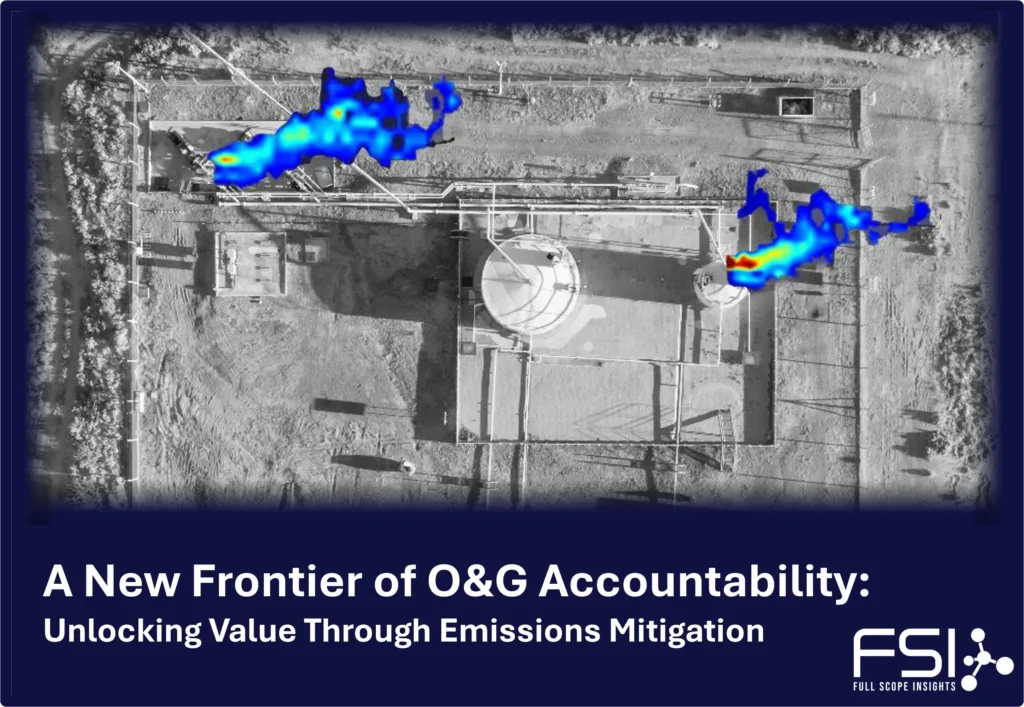
INTRODUCTION
Calculating, disclosing, and reducing greenhouse gas emissions generated from the exploration and production of hydrocarbons remains a hot topic and focus area of many operators, regulators, investors and increasingly informed downstream customers. The U.S. oil and gas (“O&G”) sector has made significant strides in reducing emissions intensity which we analyze as a measure of carbon dioxide equivalent (“tCO2e”). This factors the global warming potential of greenhouse gases (“GHGs”) such as methane and carbon dioxide emitted through the extraction and production process per unit of hydrocarbon production (barrel of oil equivalent: “BOE”). As shown in Figure 1, the U.S. O&G sector has collectively reduced emissions intensity by over 50% over the past 20-year period while more than doubling total production.
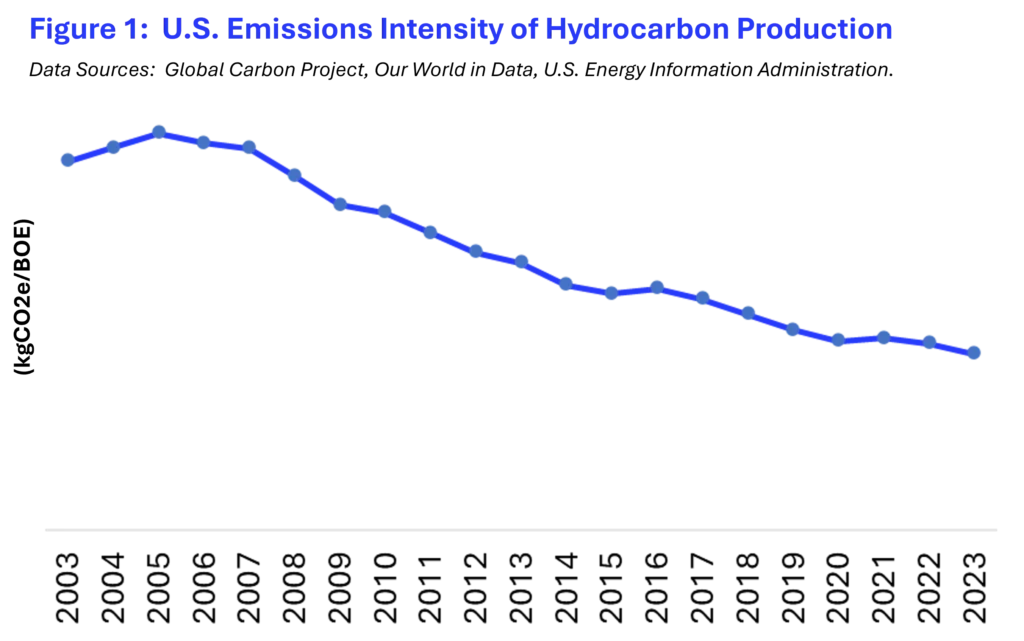
This encouraging trend is the result of the unconventional shale revolution – one of the most innovative periods in O&G history. By combining innovative facility engineering, process improvement, and technology, U.S. energy producers and their energy service support partners have continued lower O&G production costs while reducing associated fugitive emissions. More specifically, this is often achieved through optimizing flaring, thermal combustion efficiency, capturing tank battery emissions through vapor recovery, reducing leaks from pneumatic devices, and leveraging oilfield service company and technology partnerships to monitor, manage and reduce emissions across the wellsite.
The energy industry is embarking on the next frontier of O&G accountability, unlocking value through emissions control. Driven by a confluence of regulatory pressures, technological advancements, and corporate sustainability goals, upstream and midstream operators are increasingly prioritizing methane reduction. This paradigm shift is not merely a compliance exercise but a strategic imperative, enabling companies to enhance their environmental credentials, mitigate climate risks, and unlock new business opportunities. By investing in cutting-edge emissions control solutions, operators can position themselves as industry leaders, contributing to a more sustainable future while safeguarding their bottom line.
REGULATORY CRACKDOWN & INCREASING EPA FINES
Intensified EPA Clean Air Act Emissions Fines
The Clean Air Act (CAA) of 1963, subsequently amended, authorizes the Environmental Protection Agency (EPA) to establish national standards for air quality. For the O&G sector, the CAA’s New Source Performance Standards (NSPS) mandate emission limits for new or modified facilities. The NSPS, specifically the Oil and Natural Gas Sector Source Category (OOOOb/c), sets emission limits for various operations, including well completions, pneumatic controllers, and compressor stations. These regulations compel operators to report, investigate, and remediate significant leaks, particularly at high-polluting facilities.
Our analysis of the EPA’s facility emissions database reveals a growing trend of substantial fines, often reaching up to $15 million or more per penalty, levied against operators for high-profile emissions leaks. See Figure 2. While the CAA provides a national framework, states like California, Colorado, and New Mexico have enacted even stricter emissions regulations for O&G, each with unique compliance requirements and potential penalties.
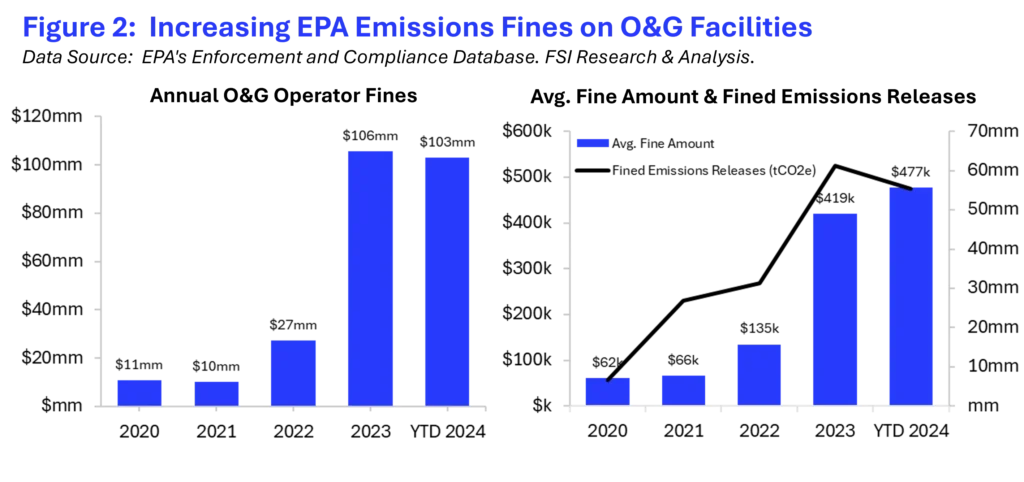
Rising Importance of Integrity and Accountability in Operator GHG Reporting
The U.S. EPA’s Greenhouse Gas Reporting Program (“GHGRP”) mandates annual reporting of GHG emissions from large emitting facilities, including those in the O&G sector. Each year, approximately 7,700 facilities submit emissions data, which the EPA makes publicly available in the 4th quarter of every year. This dataset includes information from approximately 6,500 direct point emitters, 450 O&G facilities, 350 gathering & boosting facilities, 164 transmission pipelines, and 235 utilities and other emitters.
In our analysis of the O&G facility disclosures from the latest GHGRP database (~450 discrete facilities), released by the EPA in Q4 2024 for 2023 reporting facilities, we aggregated data under parent operator organizations as identified by the EPA. It is important to highlight that these ~450 facilities represent only a small fraction of the total U.S. producing well population and relevant upstream scope 1 fugitive and stationary combustion emissions.
Our analysis of the latest GHGRP data reveals a mixed picture, influenced by factors such as M&A activity and data quality issues. Many operators still rely on estimates and imprecise emissions factors, hindering accurate reporting. Few operators have implemented full-field, real-time emissions monitoring technologies, which are essential for achieving higher-integrity emissions disclosures. See Figure 3.
While operator-specific trends are inconsistent, the total reported figures tell an encouraging story. Total EPA reported emissions from larger facilities in scope of the EPA reporting requiremnts have declined by approximately 7% since 2020, even as U.S. hydrocarbon production has increased by an estimated 13–14% during the same period.
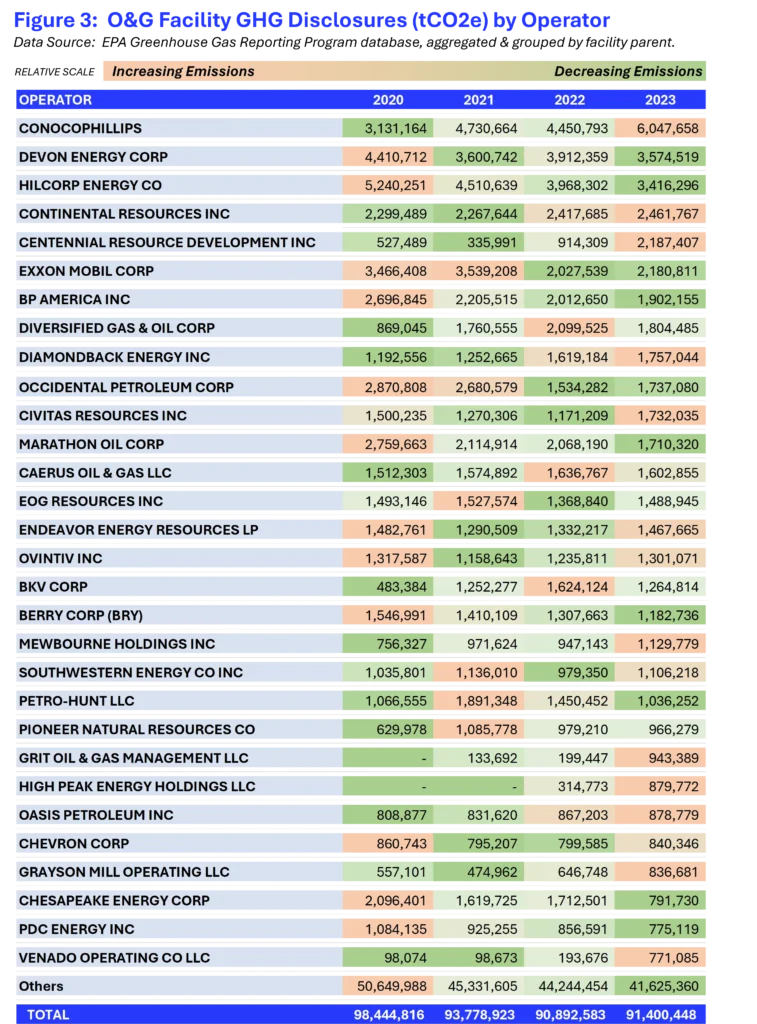
Aerial Surveillance and Satellite Monitoring: A New Era of Accountability
In 2019, the EPA embarked on a proactive approach to emissions monitoring, conducting aerial flyovers of the Permian Basin in New Mexico and Texas. Equipped with infrared cameras, these flights enabled the identification of significant methane and volatile organic compound (VOC) releases. This initiative underscored the government’s commitment to holding high emitters accountable.
More recently, private and non-profit organizations have launched satellites, such as MethaneSAT, to monitor emissions globally. MethaneSAT, a satellite launched in 2024, is revolutionizing transparency of global methane emissions monitoring. Backed by the Environmental Defense Fund and other organizations including Google, this satellite provides data on emission sources and hot spots. Satellite data, while less precise than ground-level monitoring, is valuable for regulators, the public, and environmental groups to identify emissions hotspots, track trends, and advocate for stronger regulations. Of similar importance, satellite data empowers the public and environmental groups to monitor emissions and advocate for stronger regulations, fostering a more transparent and accountable O&G industry.
As a result, the O&G industry faces increasing scrutiny and public pressure to improve emissions management practices. The days of opacity and impunity are waning. See Figure 4.
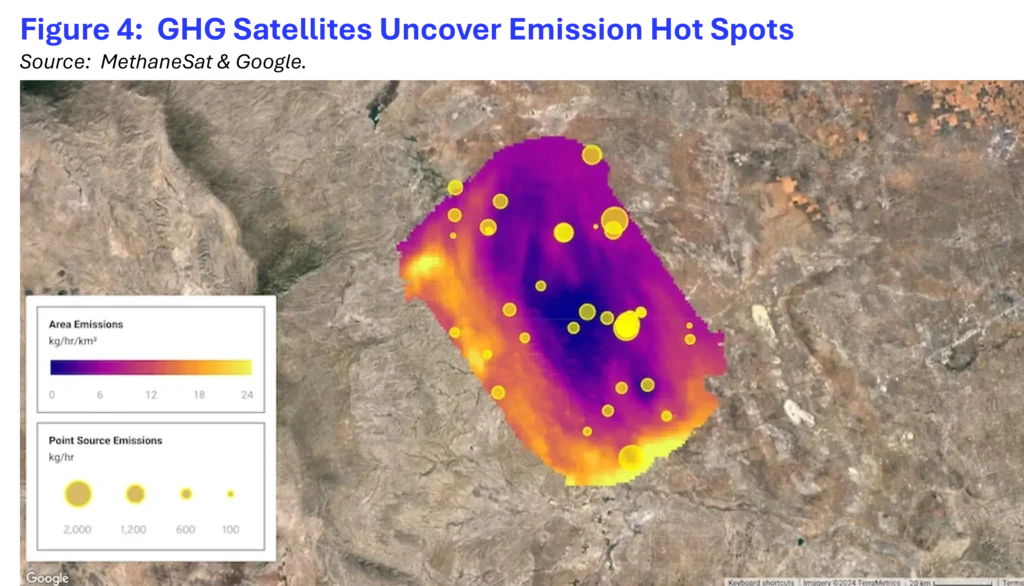
The Upcoming Methane Tax in 2025
2024 is a pivotal year for methane emissions reporting. As the final “free look” year, operators will soon face significant consequences for excessive emissions. Beginning in 2025, the Inflation Reduction Act of 2022 authorizes a “methane tax” on facilities emitting substantial quantities of methane, imposing both regulatory penalties and financial burdens.
The EPA’s Methane Emissions Reduction Program, established under Section 136 of the Clean Air Act, empowers the agency to levy a Waste Emissions Charge (WEC) on facilities exceeding specific emissions thresholds. The recently finalized WEC rule imposes charges starting at $900 per metric ton in 2024, escalating to $1,500 by 2026.
For operators, the risks are substantial. Undetected leaks can incur severe WEC penalties, alongside reputational damage and potential additional regulatory actions. The EPA estimates that these levies will prevent the release of 1.2 million metric tons of methane into the atmosphere through 2035, yielding climate benefits valued at up to $2 billion.
Political Considerations: A “Scalpel versus Sledgehammer Approach” under New Trump Administration
Under a new Trump administration in 2025, the EPA could initiate efforts to roll back and replace Biden-era methane regulations however, many experts assert that such actions will take very long and would not exempt Trump’s EPA from the legal obligation to implement the fee.
In a recent Veriten podcast interview titled “What Energy Looks Like Over the Next Four Years,” Anne Bradbury, CEO of the American Exploration & Production Council, described the process as a “scalpel versus sledgehammer approach” when addressing the potential repeal or amendment of previous administration policies on climate and energy regulations. She noted that efforts would likely focus on targeted elements versus a more complex and challenging full repeal.
Even with a supportive administration, reversing regulations involves navigating a complex process that includes public notice, justification, and review periods—steps that can take months or even years. For example, despite prioritizing it from the outset, the Biden administration took nearly three years to finalize its signature methane fee rule. These delays highlight the inherent procedural challenges of the U.S. political and regulatory landscape, reinforcing our view that operators have no choice but to continue investing in and advancing emissions reduction efforts.
European & U.S. Operators Lead Sustainable Commitments
O&G operators are in the competitive business of producing and marketing global commodities. We have seen recently that top European and U.S. operators have used decarbonization efforts to begin differentiating themselves to investors, stakeholders, and in some cases downstream buyers by lowering the scope 1 (direct), scope 2 (indirect) and scope 3 (supply chain) emissions from the production, extraction and downstream monetization. For example, EQT, a leading U.S. natural gas producer, recently touted itself as “the first traditional energy company of scale in the world to achieve net zero on a Scope 1 and Scope 2 basis.” American oil and gas production, as a whole, is now among the “cleanest” produced in the world with supporting transparent data that supports a theme of improvement over the last several decades.
The Oil & Gas Methane Partnership & Industry Collaborations
O&G operators are increasingly adopting voluntary measures to demonstrate environmental stewardship and align with global climate goals. One of the most prominent efforts is increasing participation in initiatives like the Oil & Gas Methane Partnership (“OGMP 2.0”). This initiative requires operators to implement comprehensive monitoring, report emissions with increasing accuracy, and set ambitious targets for near-zero methane emissions by 2030. Many top U.S. operators have joined the coalition of more than 145 companies around the world. See Figure 5.
Other voluntary efforts include joining the Methane Guiding Principles, a commitment to reduce methane emissions with the support of training and tools, and the ONE Future Coalition, which focuses on achieving a methane intensity of less than 1% in the natural gas supply chain by 2025. These actions are complemented by corporate commitments to net-zero emissions, with many operators setting targets for 2050 or earlier. In addition to scope 1 and 2 emissions reductions, these companies are increasingly considering scope 3 emissions and looking at innovative solutions such as carbon capture, utilization, and storage (CCUS) to address emissions from their entire value chain.
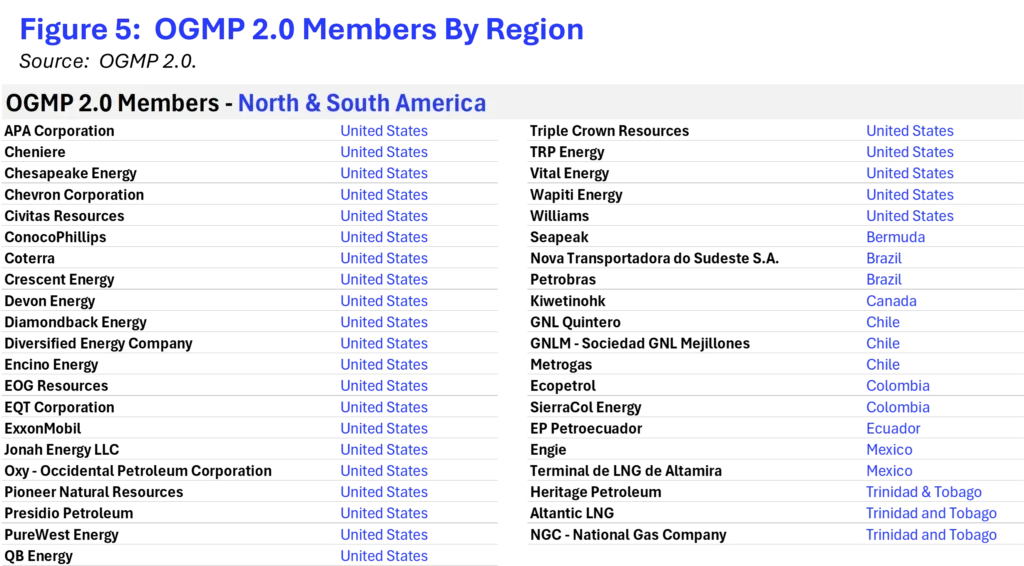
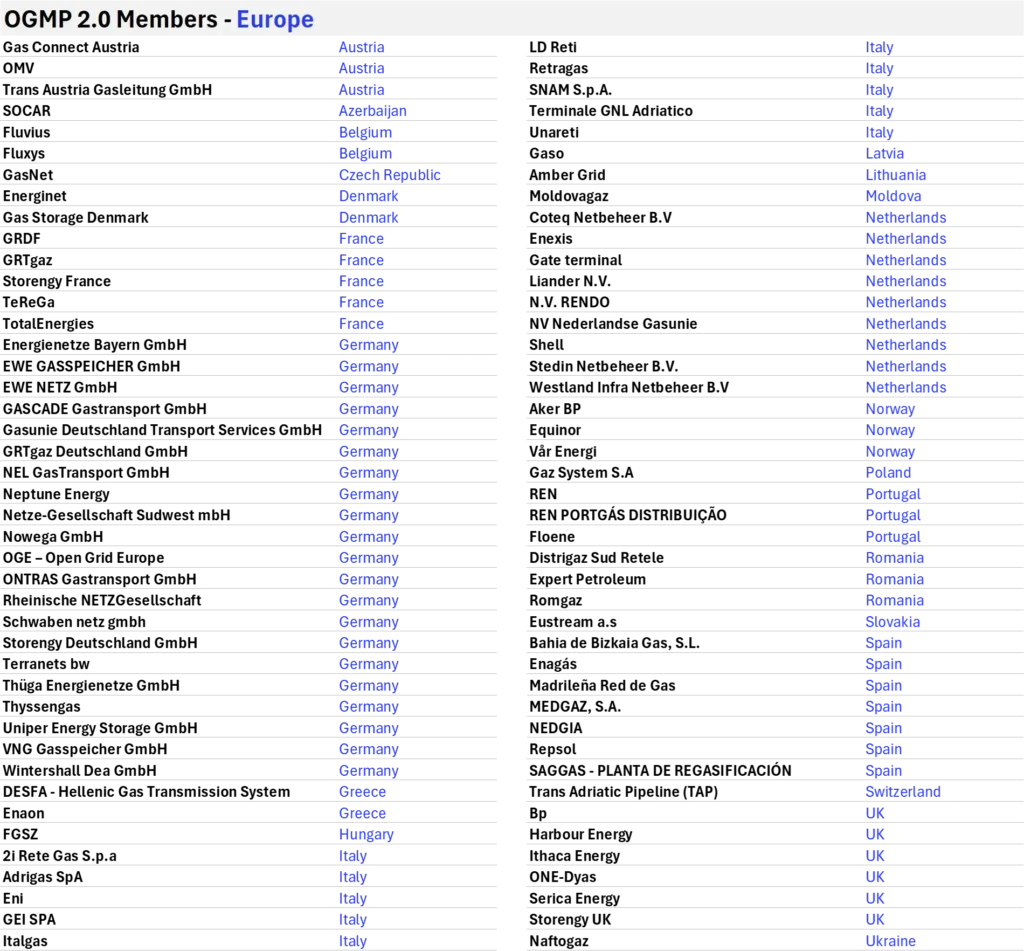

EMISSIONS MONITORING LANDSCAPE: MULTI-FACETED APPROACHES
Emissions Detection Technology Landscape
Effectively addressing emissions across upstream and midstream operations requires an integrated and adaptable approach. Given the diverse and complex sources of emissions, no single technology can meet every challenge. Instead, a strategic combination of satellite systems, aerial infrared surveillance, and advanced ground-based sensors is essential for comprehensive detection and mitigation.
The emissions monitoring landscape is undergoing rapid transformation, fueled by a wave of innovative entrants and emerging technologies designed to enhance precision and accountability. These advancements are redefining how emissions are detected, quantified, and managed. Yet, operators face significant challenges in navigating this evolving market. The growing fragmentation, coupled with rapidly advancing technologies and declining cost curves, makes choosing the right technology suite increasingly complex. Operators must balance factors such as cost, inspection accuracy, inspection frequency, data security, and seamless integration with existing systems to ensure effective and sustainable emissions management. See Figure 6.
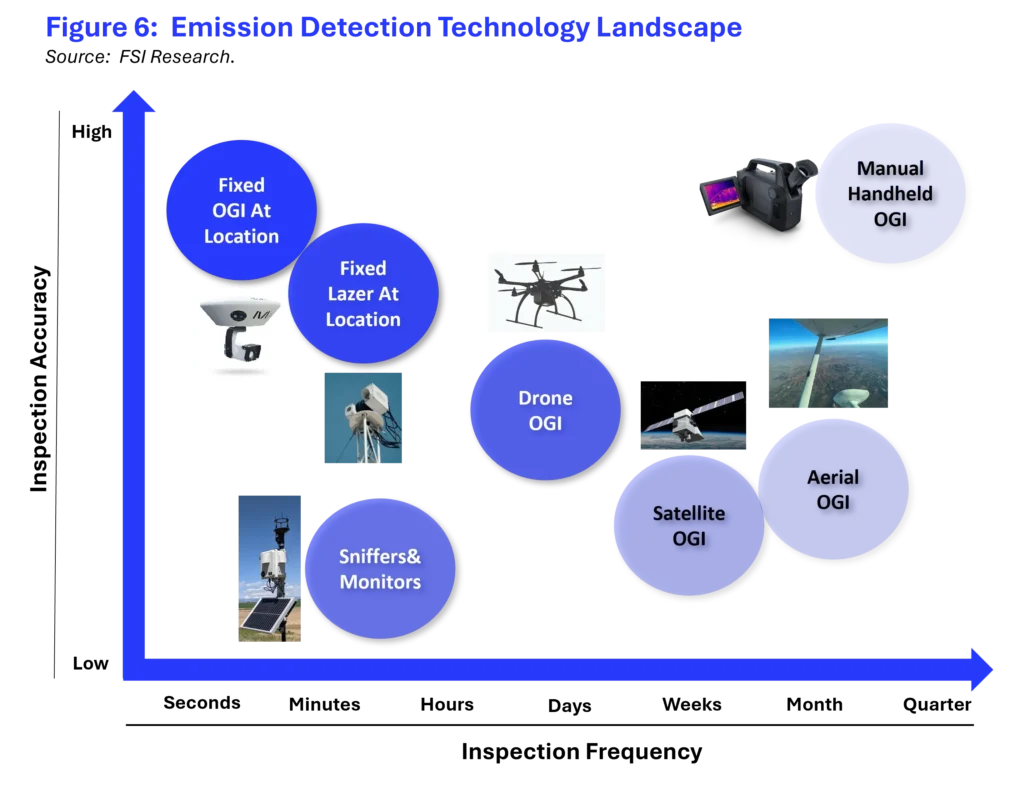
Value in Quantifiable, Low-Emissions Production
The demand for “responsibly sourced gas” has spurred technology companies and operators to adopt data-driven, empirical inventory systems. These systems seamlessly integrate real-time monitoring, aerial surveys, and advanced modeling to achieve data-driven quantification of methane emissions. Unlike the industry’s prevalent reliance on imprecise, factor-based methods for carbon accounting, verifiable empirical emissions calculations offer a significant leap in both accuracy and validity.
Enter the emerging market of energy “certification,” a voluntary initiative that provides an operator achievement score by an administering organization pursuant to an underlying standard. Third parties verify performance and award ratings or grades to operators. Several emissions reporting and certification programs have emerged such as MIQ, Equitable Origin, Project Canary, Earn DLT and Context Labs designed to reward responsible energy producers. These programs leverage third-party, independent, site-level certifications across various extraction, production, and midstream processes.
Another player in the space is CleanConnect.ai, an emerging leader in advanced emission monitoring technology. CleanConnect has commercialized its “ProveZero” platform, which integrates source level visual monitoring and/or existing software and operator SCADA (Supervisory Control and Data Acquisition) data systems to generate molecule-level emissions intensity values through blockchain. This granular assessment of the environmental impact per unit of oil and gas produced empowers operators to cultivate greater transparency and accountability. This unique feature empowers downstream commodity buyers to reward production that prioritizes environmental responsibility. Fee Figure 7.
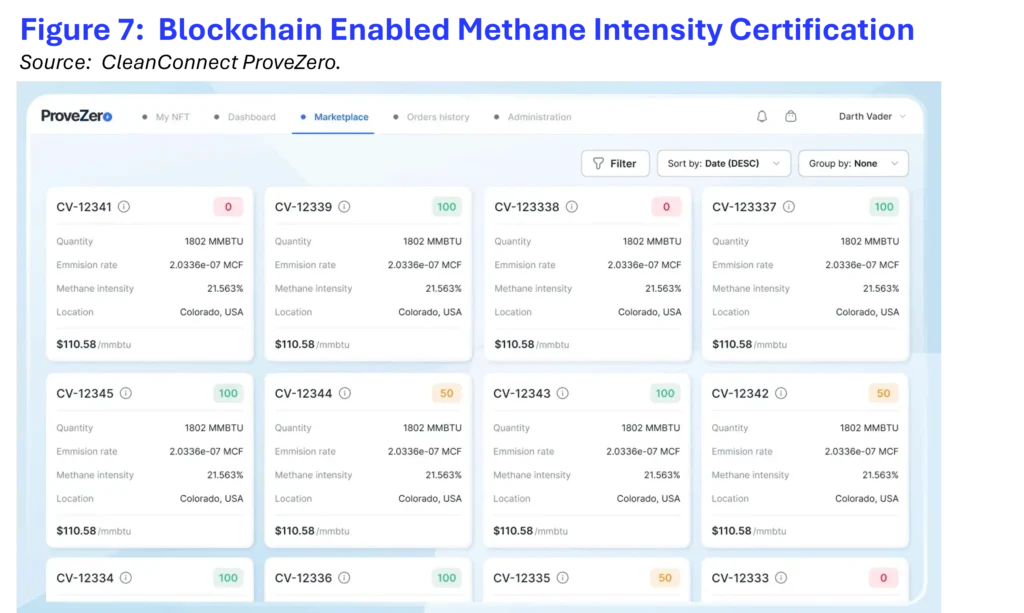
FROM DATA TO ACTION: EFFECTIVE DATA & ALERT RESPONSE
Data as a Catalyst for Change
Emissions monitoring is merely a starting point. The real value lies in transforming raw data into actionable insights, enabling operational improvements to facility equipment. As the O&G industry increasingly digitizes, tracking an ever-expanding range of data points across the production process, the challenge shifts to managing this data effectively. Operators face a critical question: How can they parse through this abundance of information to identify and act on the alerts that matter most, while avoiding false positives/negatives that lead to costly field service expenses.
Addressing the Alert Challenge Through Smart Field Services
False positives, false negatives, abundant alarms, and data workflow delays can undermine the trust and performance of emissions monitoring, delaying critical field service actions, increasing operational risks and missing super emitter events. Cimarron, a recognized leader in emissions control equipment, technology, and field services, addresses these challenges with its innovative Sytelink360® platform. See Figure 8.
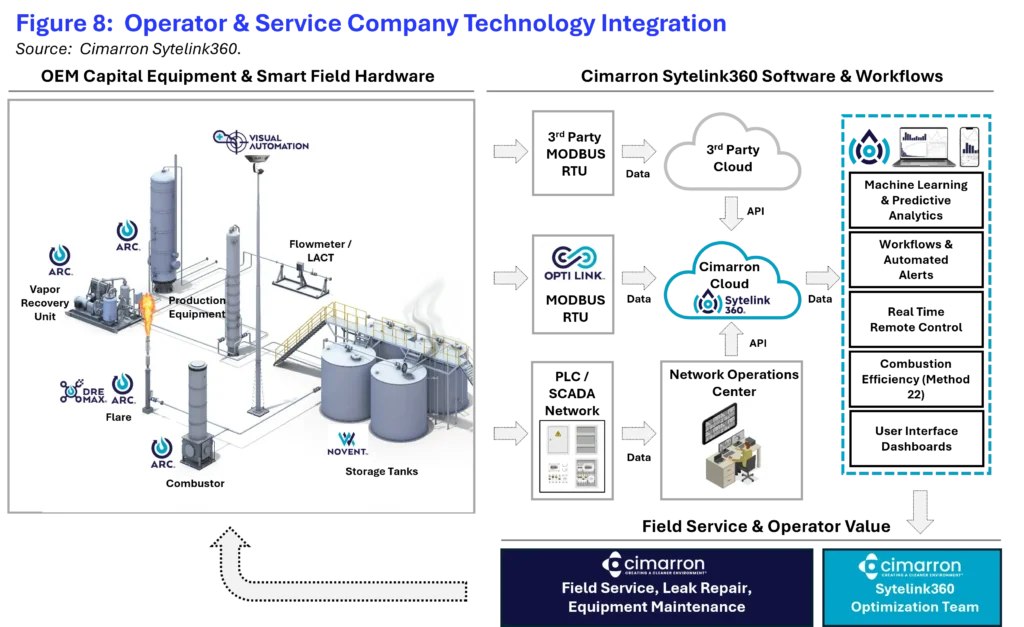
This data and system agnostic solution integrates seamlessly with existing operator SCADA systems, enhancing them with advanced connectivity, remote monitoring, and bi-directional control options. Designed to optimize emissions and production equipment—including flares, combustors, vapor recovery units, separators, dehydration units, and compressors—Sytelink360® transforms facility operations.
The platform ingests real-time equipment data, such as temperature, pressure, flow, valve status, pilot status, injection rate, and vibration metrics. By leveraging Cimarron’s emissions control expertise and applying machine-learning to these data profiles, the system identifies patterns and predicts potential equipment failures. This proactive approach enables operators to preempt equipment downtime, emissions venting, and super-emitter events through smarter field service dispatch and preventative maintenance programs.
Benefits to operators include real-time data insights through continuous monitoring, providing precise, up-to-date information that eliminates guesswork. Enhanced decision-making is supported by advanced analytics and machine learning, which cut through the noise to highlight critical issues and minimize false positives. Service efficiency is improved with automated alerts and predictive maintenance, reducing unplanned downtime and ensuring smoother operations through preventative field services and immediate, smart dispatch. Additionally, proactive management of emissions equipment helps reduce GHG outputs, aligning operations with sustainability goals.
CONCLUSION
As regulatory pressures intensify, technological advancements accelerate, and stakeholder expectations rise, O&G emissions control investment is no longer optional—it’s a strategic necessity. The industry’s ability to innovate and adapt has already driven impressive reductions in emissions intensity, but the path forward requires even greater collaboration, investment, and commitment.
Operators who embrace advanced emissions monitoring technologies, data-driven solutions, and proactive strategies for leak detection and repair will not only meet compliance requirements but will also unlock significant business value. From enhanced operational efficiency to reputational gains and access to emerging markets for responsibly sourced energy, the rewards for environmental stewardship may become substantial and differentiate commodities of the future. The new frontier of O&G accountability is here, and it’s a future worth investing in.
ABOUT FULL SCOPE INSIGHTS
This article was authored by August Scherer, President of Full Scope Insights (“FSI”). FSI is a management consulting firm supporting forward-thinking organizations in building business resiliency through fit-for-purpose advisory and project execution. Through strategy consulting, M&A advisory, market research, finance and accounting services, sustainability advisory, and sales & growth execution, we help clients navigate complex challenges and drive meaningful impact.
With extensive management and investment expertise across the oil and gas services and technologies, FSI has increasingly supported research, advisory, fractional solutions, sustainability and capital advisory efforts with clients innovating and/or evaluating emissions mitigation and reduction strategies across hard-to-abate sectors.
Connect with us to learn more about our advisory services.
